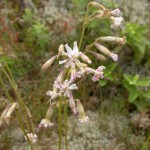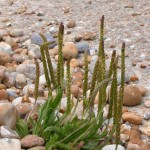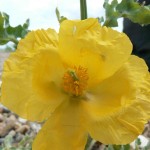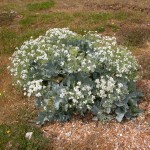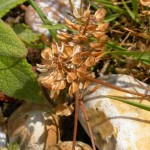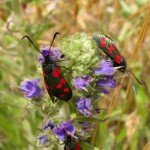The annual coach trip, on Saturday 29th June, was to Dungeness in Kent. Laid down over 5000 years, Dungeness has the largest expanse of shingle beach in Europe, with a number of rare plants, insects and birds. First stop was by the old lighthouse. On the walk to the beach, plants seen included abundant Nottingham Catchfly, Bur Chervil, Shepherd’s Cress, Biting and English Stonecrop, Yellow Horned-poppy, Sea-kale, Sea Beet, Sheep’s-bit, Buck’s-horn Plantain, Sea Campion, Slender Thistle and Rock Samphire. A Black Redstart was singing on a post within the nuclear power station complex. Six-spot Burnet Moths were nectaring on the flower heads of Viper’s-bugloss and Painted Lady, Small Tortoiseshell and Small Heath butterflies were seen.
Next stop was the nearby RSPB reserve. Some of the party visited the hides closest to the Visitor Centre. They reported the sighting of a Marsh Frog. The rest of the group followed a 2 mile trail round the reserve. The willow bushes beside the path were draped in webs which contained grey and black caterpillars. A Sedge Warbler was watched as it fed along the banks of a reed-lined dyke. It perched on a floating polystyrene block, giving good views of its eye-stripe. Whitehroats and Linnets were seen, a Cetti’s Warbler was heard and several Hobbies were hunting overhead. From the Denge Marsh hide, there were good views of Common Terns with fluffy chicks which were nesting on floating rafts. While watching a Common Lizard at the entrance to the hide, a cuckoo bumblebee was spotted, searching amongst the vegetation for a bumblebee nest to parasitize. Several Marsh Harriers were patrolling across the reed-beds at the northern end of the reserve. Finally, as the coach was leaving the reserve, there was a brief pause to inspect the nest-boxes on the warden’s house for Tree Sparrows. A number of sparrows were spotted, but the views were not good enough for a definite identification.
Pictures by Laurie and Jan Haseler
RDNHS Coach trip to Dungeness, 29-06-13; Plant species found
Shingle near Nuclear Power Plant:
| Anagallis arvensis | Scarlet Pimpernel |
| Anthriscus caucalis | Bur Chervil |
| Arctium minus | Lesser Burdock |
| Arenaria serpyllifolia | Thyme-leaved Sandwort |
| Beta vulgaris | Sea Beet |
| Carduus tenuiflorus | Slender Thistle |
| Catapodium rigidum | Fern-grass |
| Centranthus ruber | Red Valerian |
| Cirsium palustre | Marsh Thistle |
| Cochlearia danica | Danish Scurvy-grass |
| Crambe maritime | Sea-kale |
| Crithmum maritimum | Rock Samphire |
| Digitalis purpurea | Foxglove |
| Dipsacus fullonum | Teasel |
| Echium vulgare | Viper’s-bugloss |
| Epilobium hirsutum | Great Willowherb |
| Galium saxatile | Heath Bedstraw |
| Geranium molle | Dove’s-foot Crane’s-bill |
| Glaucium flavum | Yellow Horned-poppy |
| Jasione montana | Sheep’s-bit |
| Leucanthemum vulgare | Oxeye Daisy |
| Lonicera periclymenum | Honeysuckle |
| Lotus corniculatus | Common Bird’s-foot-trefoil |
| Medicago lupulina | Black Medick |
| Picris echioides | Bristly Oxtongue |
| Pilosella officinarum | Mouse-ear Hawkweed |
| Plantago coronopus | Buck’s-horn Plantain |
| Plantago lanceolata | Ribwort Plantain |
| Reseda lutea | Wild Mignonette |
| Reseda luteola | Weld |
| Rumex acetosa | Common Sorrel |
| Rumex acetosella | Sheep’s Sorrel |
| Sedum acre | Biting Stonecrop |
| Sedum anglicum | English Stonecrop |
| Senecio jacobaea | Common Ragwort |
| Silene maritima | Sea Campion |
| Silene nutans | Nottingham Catchfly |
| Sisymbrium officinale | Hedge Mustard |
| Solanum dulcamara | Bittersweet |
| Sonchus oleraceus | Smooth Sow-thistle |
| Teesdalia nudicaulis | Shepherd’s-cress (in fruit) |
| Teucrium scorodonia | Wood Sage |
| Trisetum flavescens | Yellow Oat-grass |
| Trifolium campestre | Hop Trefoil |
| Ulex europaeus | Gorse |
| Urtica dioica | Common Nettle |
Plants in bold script are typical for the special habitat (shingle beech)
RSPB Reserve, additional plant species:
| Armeria maritime | Thrift |
| Arrhenatherum elatius | False Oat-grass |
| Carlina vulgaris | Carline Thistle (last year’s fruit heads) |
| Cerastium fontanum | Common Mouse-ear |
| Ceratocapnos claviculata | Climbing Corydalis |
| Chamerion angustifolium | Rosebay Willowherb |
| Convolvulus arvensis | Field Bindweed |
| Conyza Canadensis | Canadian Fleabane |
| Cynoglossum officinale | Hound’s-tongue |
| Equisetum palustre | Marsh Horsetail |
| Erodium cicutarium | Common Stork’s-bill |
| Galium palustre | Common Marsh-bedstraw |
| Geranium dissectum | Cut-leaved Crane’s-bill |
| Hippophae rhamnoides | Sea Buckthorn |
| Hydrocotyle vulgaris | Marsh Pennywort |
| Iris pseudacorus | Yellow Iris |
| Lagurus ovatus | Hare’s-tail |
| Lathyrus nissolia | Grass Vetchling |
| Lythrum salicaria | Purple-loosestrife (last year’s fruit heads) |
| Malva sylvestris | Common Mallow |
| Myosotis arvensis | Field Forget-me-not |
| Myosotis discolor | Changing Forget-me-not |
| Ononis repens | Common Restharrow |
| Potentilla anserina | Silverweed |
| Potentilla reptans | Creeping Cinquefoil |
| Prunella vulgaris | Selfheal |
| Pulicaria dysenterica | Common Fleabane |
| Ranunculus flammula | Lesser Spearwort |
| Rubus fruticosus | Bramble |
| Tragopogon pratense | Goat’s-beard (in fruit) |
| Trifolium repens | White Clover |
| Typha latifolia | Bulrush (last year’s fruit heads) |
| Verbascum thapsus | Great Mullein (last year’s fruit heads) |
| Vicia sativa | Common Vetch |
List by Renée Grayer

